The assessment of the strengths and weaknesses
VerifiedAdded on 2022/08/25
|8
|1570
|28
AI Summary
Contribute Materials
Your contribution can guide someone’s learning journey. Share your
documents today.
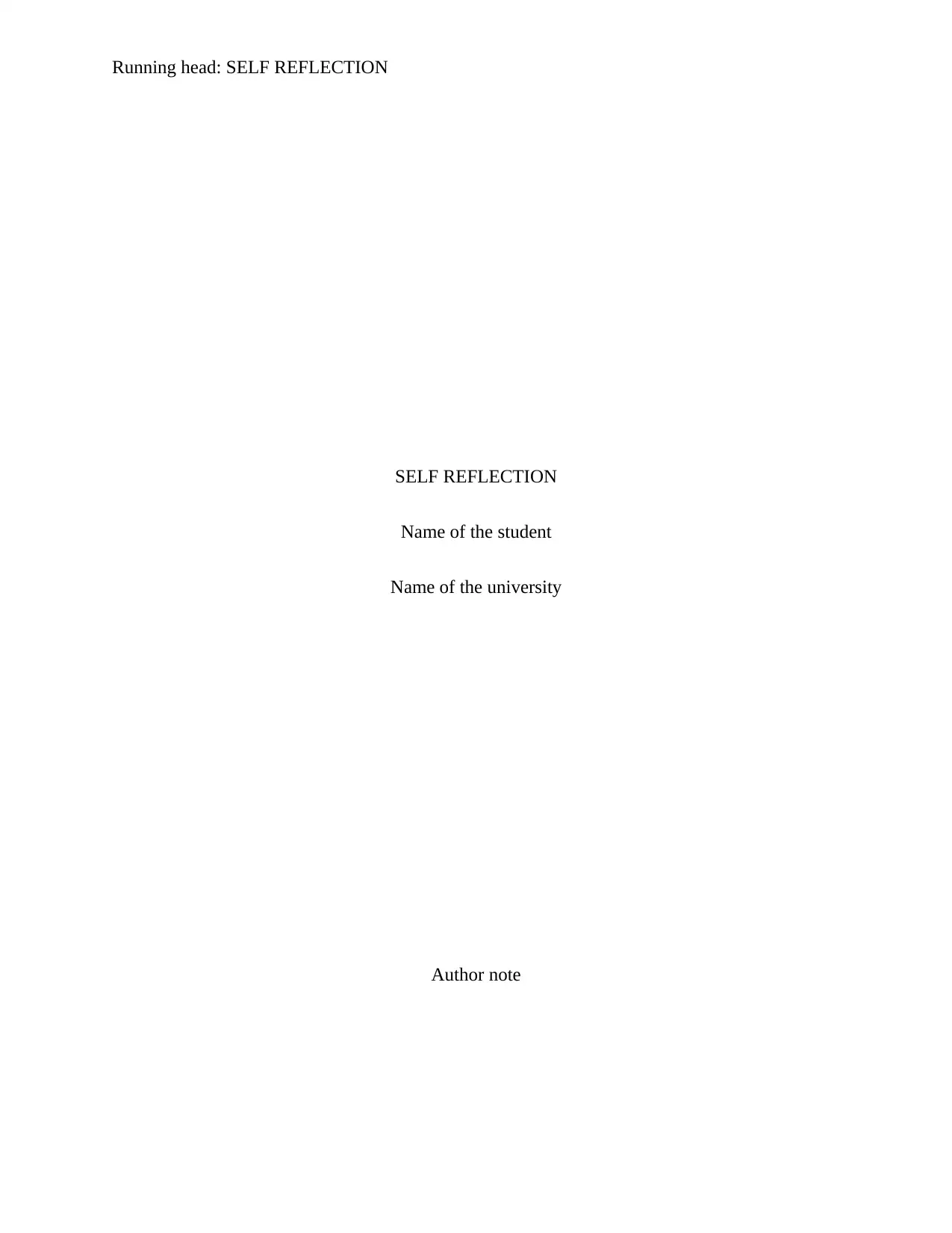
Running head: SELF REFLECTION
SELF REFLECTION
Name of the student
Name of the university
Author note
SELF REFLECTION
Name of the student
Name of the university
Author note
Secure Best Marks with AI Grader
Need help grading? Try our AI Grader for instant feedback on your assignments.
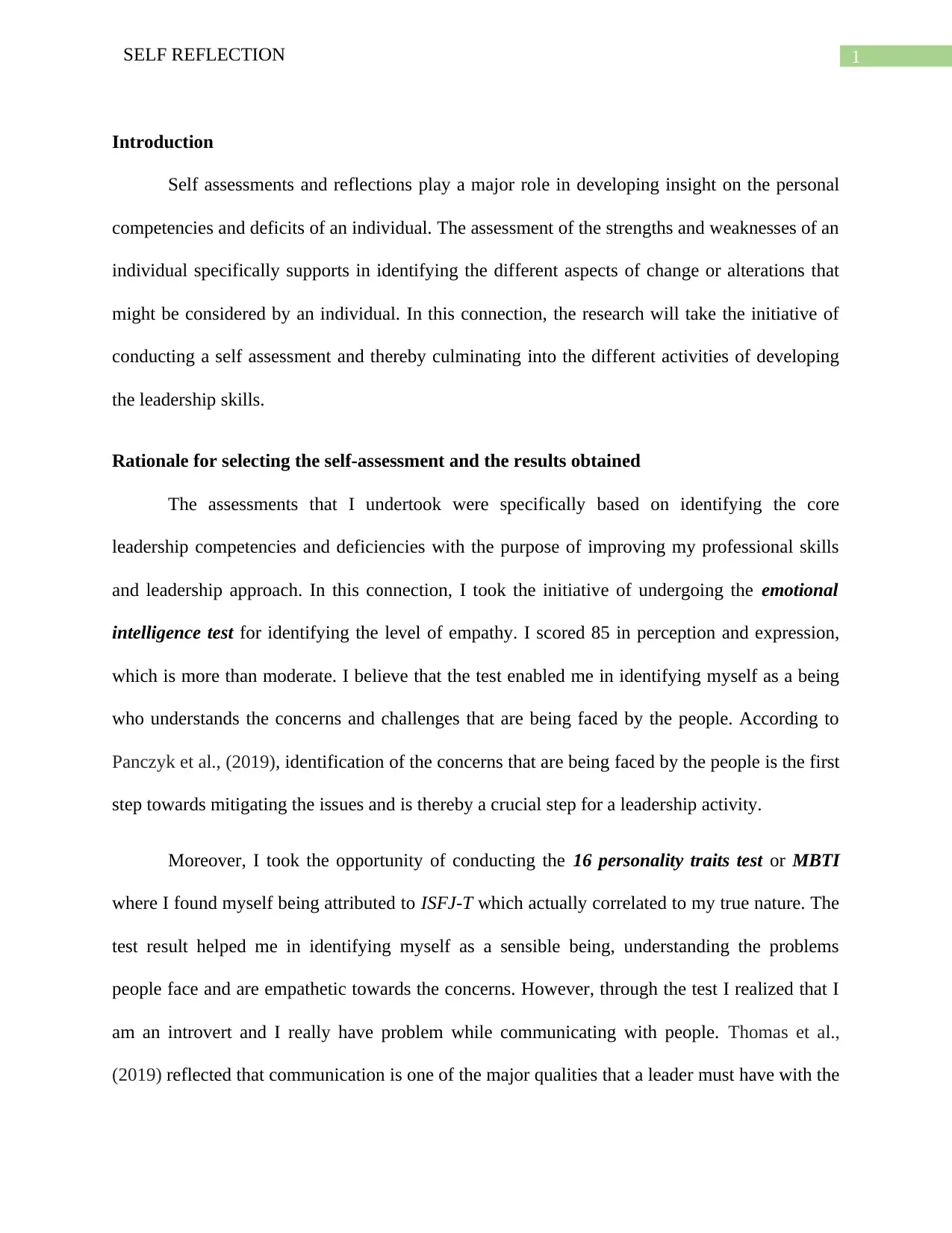
1SELF REFLECTION
Introduction
Self assessments and reflections play a major role in developing insight on the personal
competencies and deficits of an individual. The assessment of the strengths and weaknesses of an
individual specifically supports in identifying the different aspects of change or alterations that
might be considered by an individual. In this connection, the research will take the initiative of
conducting a self assessment and thereby culminating into the different activities of developing
the leadership skills.
Rationale for selecting the self-assessment and the results obtained
The assessments that I undertook were specifically based on identifying the core
leadership competencies and deficiencies with the purpose of improving my professional skills
and leadership approach. In this connection, I took the initiative of undergoing the emotional
intelligence test for identifying the level of empathy. I scored 85 in perception and expression,
which is more than moderate. I believe that the test enabled me in identifying myself as a being
who understands the concerns and challenges that are being faced by the people. According to
Panczyk et al., (2019), identification of the concerns that are being faced by the people is the first
step towards mitigating the issues and is thereby a crucial step for a leadership activity.
Moreover, I took the opportunity of conducting the 16 personality traits test or MBTI
where I found myself being attributed to ISFJ-T which actually correlated to my true nature. The
test result helped me in identifying myself as a sensible being, understanding the problems
people face and are empathetic towards the concerns. However, through the test I realized that I
am an introvert and I really have problem while communicating with people. Thomas et al.,
(2019) reflected that communication is one of the major qualities that a leader must have with the
Introduction
Self assessments and reflections play a major role in developing insight on the personal
competencies and deficits of an individual. The assessment of the strengths and weaknesses of an
individual specifically supports in identifying the different aspects of change or alterations that
might be considered by an individual. In this connection, the research will take the initiative of
conducting a self assessment and thereby culminating into the different activities of developing
the leadership skills.
Rationale for selecting the self-assessment and the results obtained
The assessments that I undertook were specifically based on identifying the core
leadership competencies and deficiencies with the purpose of improving my professional skills
and leadership approach. In this connection, I took the initiative of undergoing the emotional
intelligence test for identifying the level of empathy. I scored 85 in perception and expression,
which is more than moderate. I believe that the test enabled me in identifying myself as a being
who understands the concerns and challenges that are being faced by the people. According to
Panczyk et al., (2019), identification of the concerns that are being faced by the people is the first
step towards mitigating the issues and is thereby a crucial step for a leadership activity.
Moreover, I took the opportunity of conducting the 16 personality traits test or MBTI
where I found myself being attributed to ISFJ-T which actually correlated to my true nature. The
test result helped me in identifying myself as a sensible being, understanding the problems
people face and are empathetic towards the concerns. However, through the test I realized that I
am an introvert and I really have problem while communicating with people. Thomas et al.,
(2019) reflected that communication is one of the major qualities that a leader must have with the
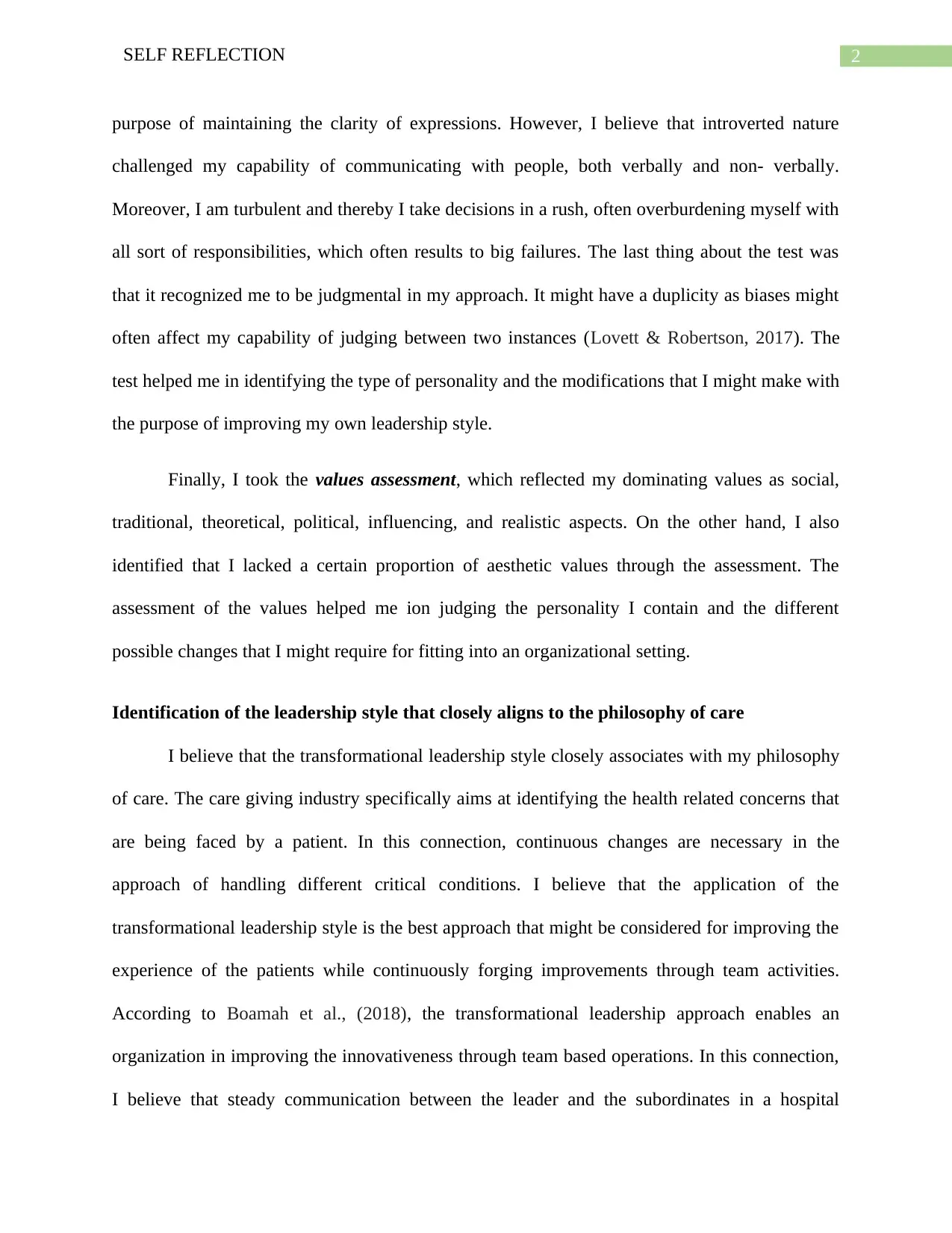
2SELF REFLECTION
purpose of maintaining the clarity of expressions. However, I believe that introverted nature
challenged my capability of communicating with people, both verbally and non- verbally.
Moreover, I am turbulent and thereby I take decisions in a rush, often overburdening myself with
all sort of responsibilities, which often results to big failures. The last thing about the test was
that it recognized me to be judgmental in my approach. It might have a duplicity as biases might
often affect my capability of judging between two instances (Lovett & Robertson, 2017). The
test helped me in identifying the type of personality and the modifications that I might make with
the purpose of improving my own leadership style.
Finally, I took the values assessment, which reflected my dominating values as social,
traditional, theoretical, political, influencing, and realistic aspects. On the other hand, I also
identified that I lacked a certain proportion of aesthetic values through the assessment. The
assessment of the values helped me ion judging the personality I contain and the different
possible changes that I might require for fitting into an organizational setting.
Identification of the leadership style that closely aligns to the philosophy of care
I believe that the transformational leadership style closely associates with my philosophy
of care. The care giving industry specifically aims at identifying the health related concerns that
are being faced by a patient. In this connection, continuous changes are necessary in the
approach of handling different critical conditions. I believe that the application of the
transformational leadership style is the best approach that might be considered for improving the
experience of the patients while continuously forging improvements through team activities.
According to Boamah et al., (2018), the transformational leadership approach enables an
organization in improving the innovativeness through team based operations. In this connection,
I believe that steady communication between the leader and the subordinates in a hospital
purpose of maintaining the clarity of expressions. However, I believe that introverted nature
challenged my capability of communicating with people, both verbally and non- verbally.
Moreover, I am turbulent and thereby I take decisions in a rush, often overburdening myself with
all sort of responsibilities, which often results to big failures. The last thing about the test was
that it recognized me to be judgmental in my approach. It might have a duplicity as biases might
often affect my capability of judging between two instances (Lovett & Robertson, 2017). The
test helped me in identifying the type of personality and the modifications that I might make with
the purpose of improving my own leadership style.
Finally, I took the values assessment, which reflected my dominating values as social,
traditional, theoretical, political, influencing, and realistic aspects. On the other hand, I also
identified that I lacked a certain proportion of aesthetic values through the assessment. The
assessment of the values helped me ion judging the personality I contain and the different
possible changes that I might require for fitting into an organizational setting.
Identification of the leadership style that closely aligns to the philosophy of care
I believe that the transformational leadership style closely associates with my philosophy
of care. The care giving industry specifically aims at identifying the health related concerns that
are being faced by a patient. In this connection, continuous changes are necessary in the
approach of handling different critical conditions. I believe that the application of the
transformational leadership style is the best approach that might be considered for improving the
experience of the patients while continuously forging improvements through team activities.
According to Boamah et al., (2018), the transformational leadership approach enables an
organization in improving the innovativeness through team based operations. In this connection,
I believe that steady communication between the leader and the subordinates in a hospital
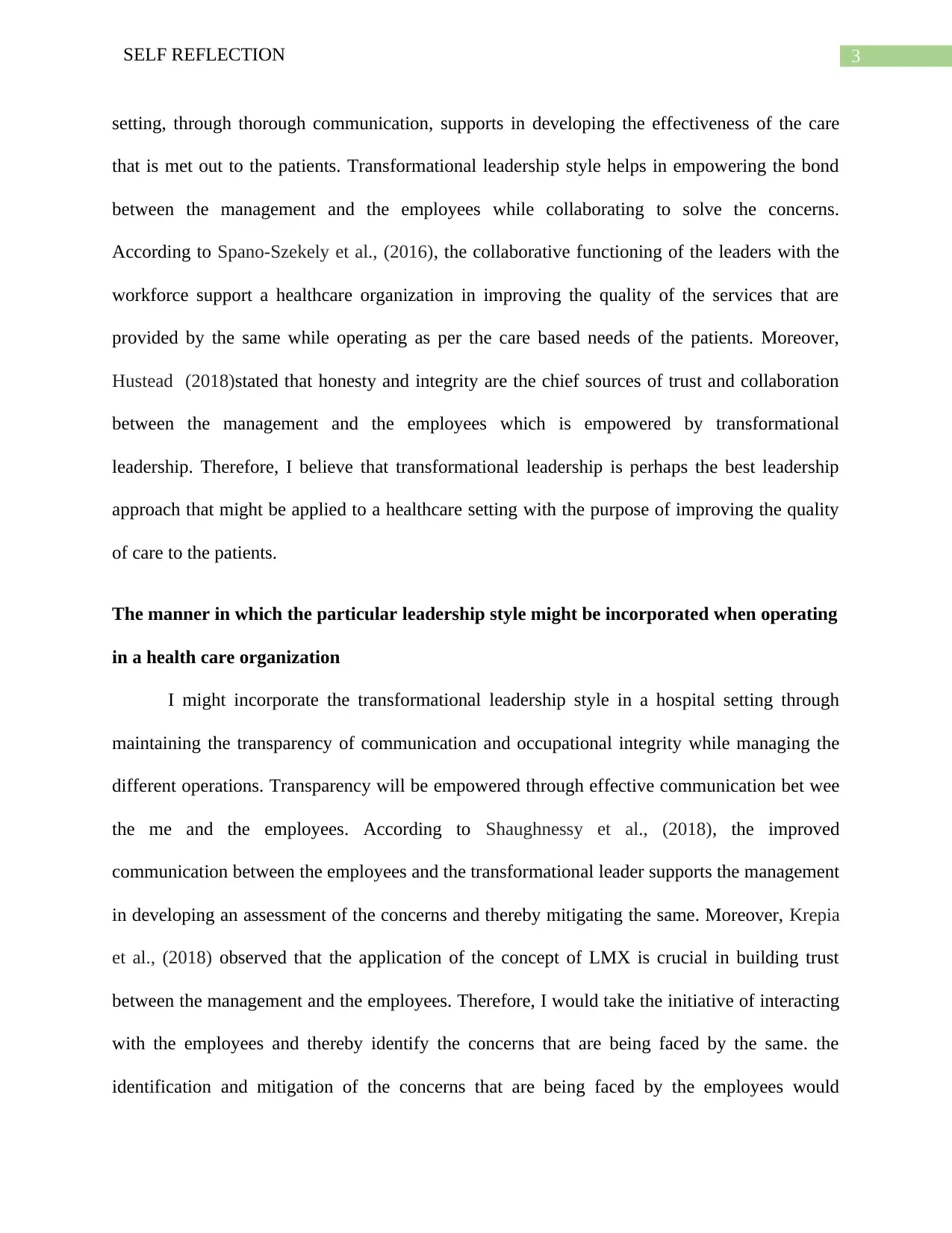
3SELF REFLECTION
setting, through thorough communication, supports in developing the effectiveness of the care
that is met out to the patients. Transformational leadership style helps in empowering the bond
between the management and the employees while collaborating to solve the concerns.
According to Spano-Szekely et al., (2016), the collaborative functioning of the leaders with the
workforce support a healthcare organization in improving the quality of the services that are
provided by the same while operating as per the care based needs of the patients. Moreover,
Hustead (2018)stated that honesty and integrity are the chief sources of trust and collaboration
between the management and the employees which is empowered by transformational
leadership. Therefore, I believe that transformational leadership is perhaps the best leadership
approach that might be applied to a healthcare setting with the purpose of improving the quality
of care to the patients.
The manner in which the particular leadership style might be incorporated when operating
in a health care organization
I might incorporate the transformational leadership style in a hospital setting through
maintaining the transparency of communication and occupational integrity while managing the
different operations. Transparency will be empowered through effective communication bet wee
the me and the employees. According to Shaughnessy et al., (2018), the improved
communication between the employees and the transformational leader supports the management
in developing an assessment of the concerns and thereby mitigating the same. Moreover, Krepia
et al., (2018) observed that the application of the concept of LMX is crucial in building trust
between the management and the employees. Therefore, I would take the initiative of interacting
with the employees and thereby identify the concerns that are being faced by the same. the
identification and mitigation of the concerns that are being faced by the employees would
setting, through thorough communication, supports in developing the effectiveness of the care
that is met out to the patients. Transformational leadership style helps in empowering the bond
between the management and the employees while collaborating to solve the concerns.
According to Spano-Szekely et al., (2016), the collaborative functioning of the leaders with the
workforce support a healthcare organization in improving the quality of the services that are
provided by the same while operating as per the care based needs of the patients. Moreover,
Hustead (2018)stated that honesty and integrity are the chief sources of trust and collaboration
between the management and the employees which is empowered by transformational
leadership. Therefore, I believe that transformational leadership is perhaps the best leadership
approach that might be applied to a healthcare setting with the purpose of improving the quality
of care to the patients.
The manner in which the particular leadership style might be incorporated when operating
in a health care organization
I might incorporate the transformational leadership style in a hospital setting through
maintaining the transparency of communication and occupational integrity while managing the
different operations. Transparency will be empowered through effective communication bet wee
the me and the employees. According to Shaughnessy et al., (2018), the improved
communication between the employees and the transformational leader supports the management
in developing an assessment of the concerns and thereby mitigating the same. Moreover, Krepia
et al., (2018) observed that the application of the concept of LMX is crucial in building trust
between the management and the employees. Therefore, I would take the initiative of interacting
with the employees and thereby identify the concerns that are being faced by the same. the
identification and mitigation of the concerns that are being faced by the employees would
Secure Best Marks with AI Grader
Need help grading? Try our AI Grader for instant feedback on your assignments.
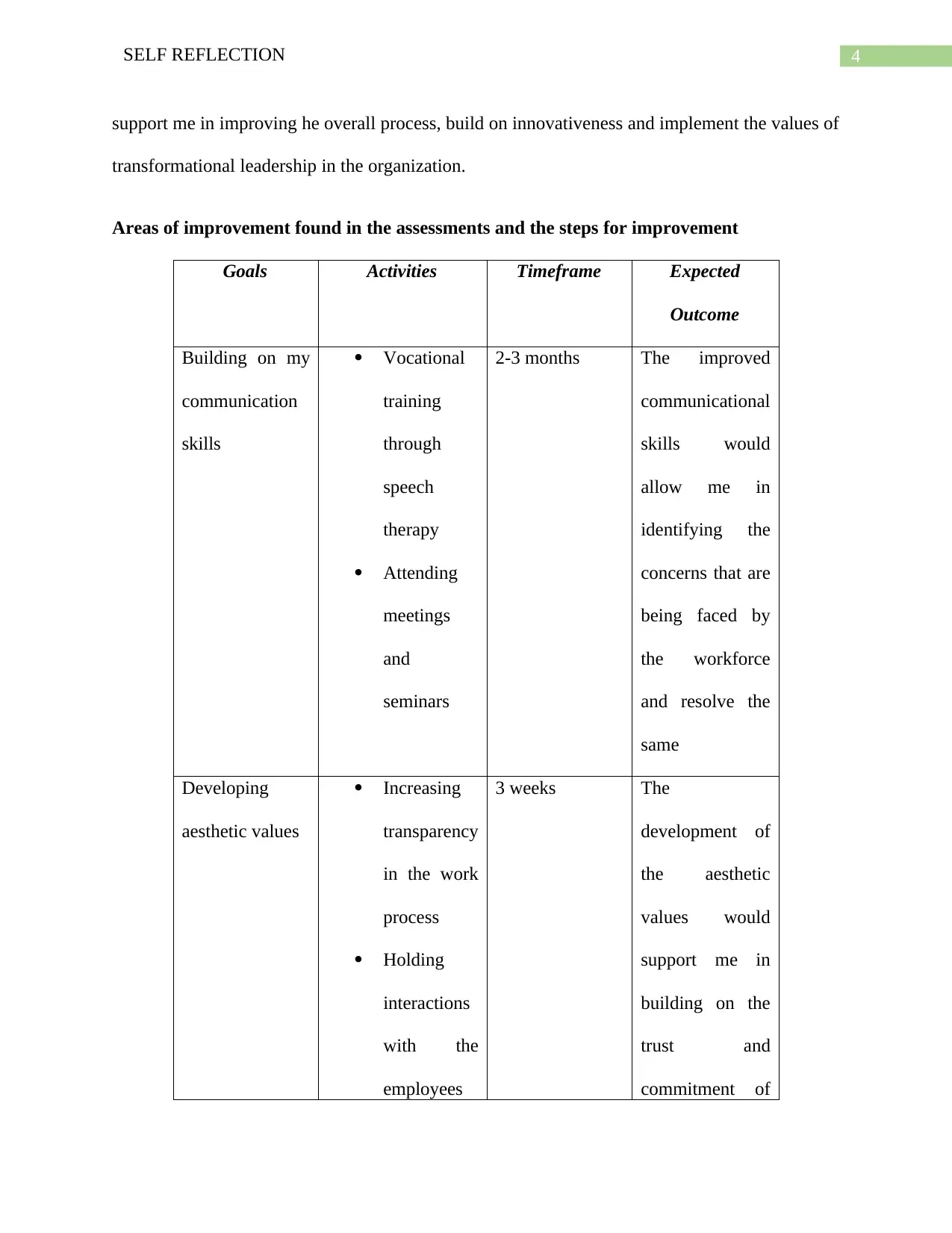
4SELF REFLECTION
support me in improving he overall process, build on innovativeness and implement the values of
transformational leadership in the organization.
Areas of improvement found in the assessments and the steps for improvement
Goals Activities Timeframe Expected
Outcome
Building on my
communication
skills
Vocational
training
through
speech
therapy
Attending
meetings
and
seminars
2-3 months The improved
communicational
skills would
allow me in
identifying the
concerns that are
being faced by
the workforce
and resolve the
same
Developing
aesthetic values
Increasing
transparency
in the work
process
Holding
interactions
with the
employees
3 weeks The
development of
the aesthetic
values would
support me in
building on the
trust and
commitment of
support me in improving he overall process, build on innovativeness and implement the values of
transformational leadership in the organization.
Areas of improvement found in the assessments and the steps for improvement
Goals Activities Timeframe Expected
Outcome
Building on my
communication
skills
Vocational
training
through
speech
therapy
Attending
meetings
and
seminars
2-3 months The improved
communicational
skills would
allow me in
identifying the
concerns that are
being faced by
the workforce
and resolve the
same
Developing
aesthetic values
Increasing
transparency
in the work
process
Holding
interactions
with the
employees
3 weeks The
development of
the aesthetic
values would
support me in
building on the
trust and
commitment of
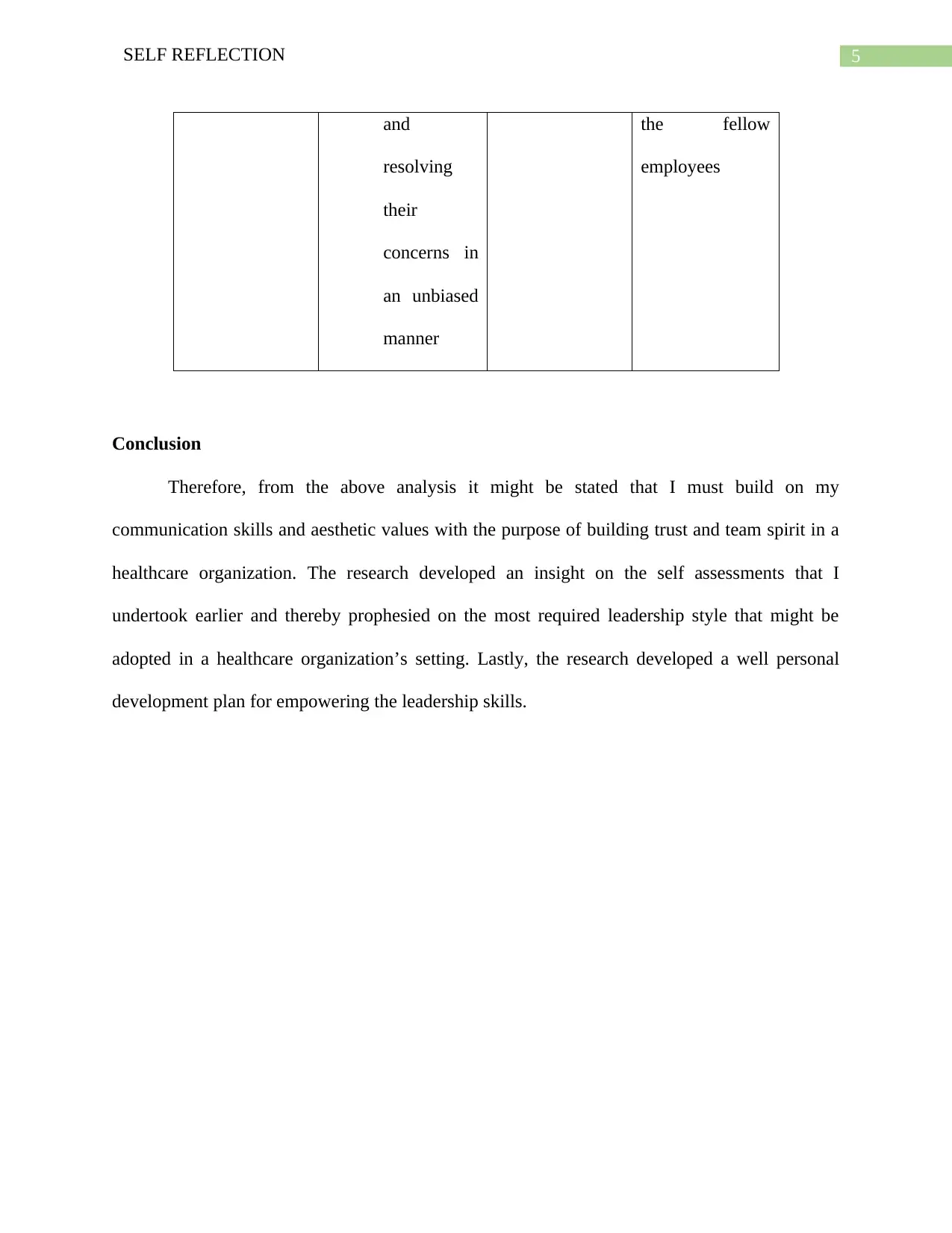
5SELF REFLECTION
and
resolving
their
concerns in
an unbiased
manner
the fellow
employees
Conclusion
Therefore, from the above analysis it might be stated that I must build on my
communication skills and aesthetic values with the purpose of building trust and team spirit in a
healthcare organization. The research developed an insight on the self assessments that I
undertook earlier and thereby prophesied on the most required leadership style that might be
adopted in a healthcare organization’s setting. Lastly, the research developed a well personal
development plan for empowering the leadership skills.
and
resolving
their
concerns in
an unbiased
manner
the fellow
employees
Conclusion
Therefore, from the above analysis it might be stated that I must build on my
communication skills and aesthetic values with the purpose of building trust and team spirit in a
healthcare organization. The research developed an insight on the self assessments that I
undertook earlier and thereby prophesied on the most required leadership style that might be
adopted in a healthcare organization’s setting. Lastly, the research developed a well personal
development plan for empowering the leadership skills.
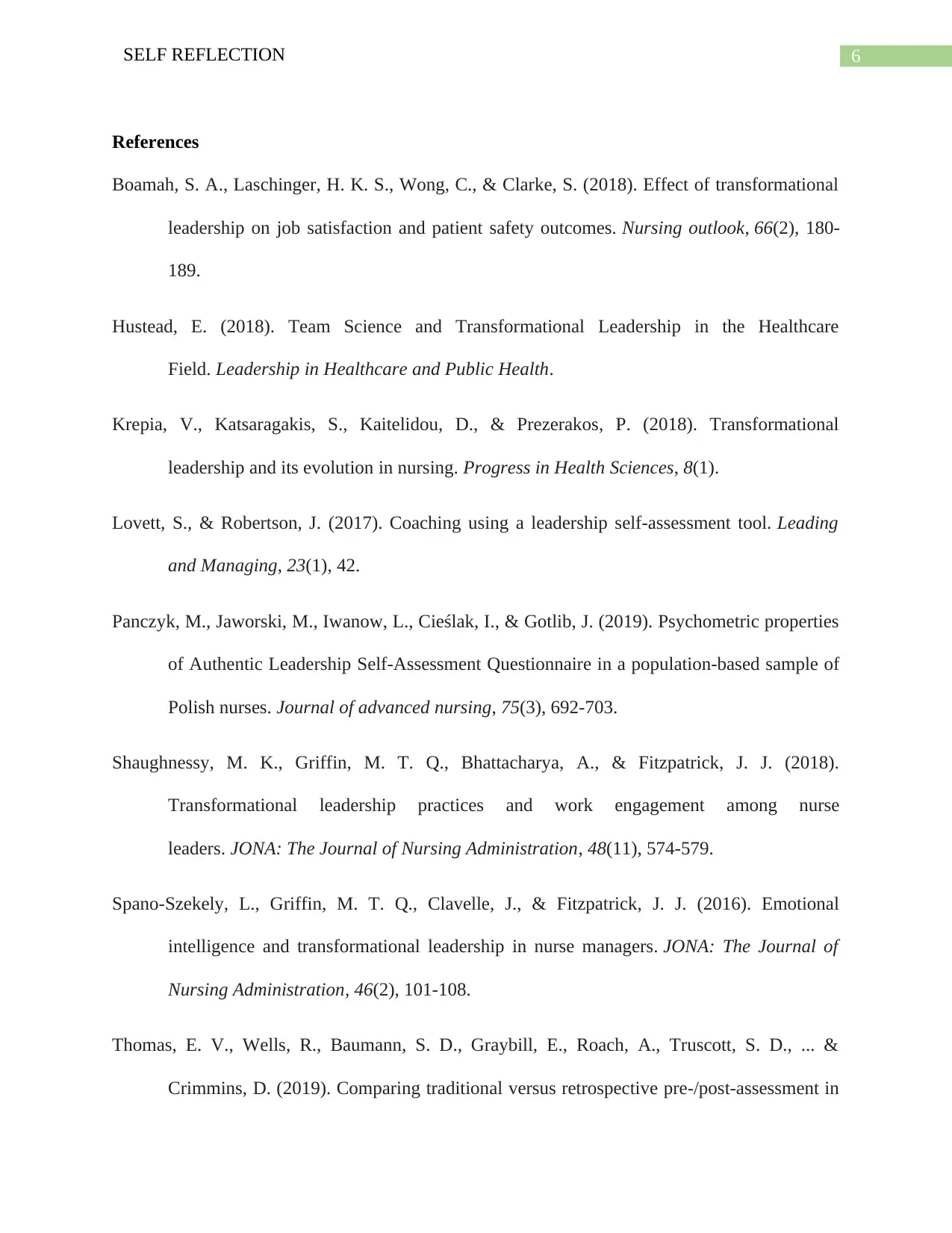
6SELF REFLECTION
References
Boamah, S. A., Laschinger, H. K. S., Wong, C., & Clarke, S. (2018). Effect of transformational
leadership on job satisfaction and patient safety outcomes. Nursing outlook, 66(2), 180-
189.
Hustead, E. (2018). Team Science and Transformational Leadership in the Healthcare
Field. Leadership in Healthcare and Public Health.
Krepia, V., Katsaragakis, S., Kaitelidou, D., & Prezerakos, P. (2018). Transformational
leadership and its evolution in nursing. Progress in Health Sciences, 8(1).
Lovett, S., & Robertson, J. (2017). Coaching using a leadership self-assessment tool. Leading
and Managing, 23(1), 42.
Panczyk, M., Jaworski, M., Iwanow, L., Cieślak, I., & Gotlib, J. (2019). Psychometric properties
of Authentic Leadership Self‐Assessment Questionnaire in a population‐based sample of
Polish nurses. Journal of advanced nursing, 75(3), 692-703.
Shaughnessy, M. K., Griffin, M. T. Q., Bhattacharya, A., & Fitzpatrick, J. J. (2018).
Transformational leadership practices and work engagement among nurse
leaders. JONA: The Journal of Nursing Administration, 48(11), 574-579.
Spano-Szekely, L., Griffin, M. T. Q., Clavelle, J., & Fitzpatrick, J. J. (2016). Emotional
intelligence and transformational leadership in nurse managers. JONA: The Journal of
Nursing Administration, 46(2), 101-108.
Thomas, E. V., Wells, R., Baumann, S. D., Graybill, E., Roach, A., Truscott, S. D., ... &
Crimmins, D. (2019). Comparing traditional versus retrospective pre-/post-assessment in
References
Boamah, S. A., Laschinger, H. K. S., Wong, C., & Clarke, S. (2018). Effect of transformational
leadership on job satisfaction and patient safety outcomes. Nursing outlook, 66(2), 180-
189.
Hustead, E. (2018). Team Science and Transformational Leadership in the Healthcare
Field. Leadership in Healthcare and Public Health.
Krepia, V., Katsaragakis, S., Kaitelidou, D., & Prezerakos, P. (2018). Transformational
leadership and its evolution in nursing. Progress in Health Sciences, 8(1).
Lovett, S., & Robertson, J. (2017). Coaching using a leadership self-assessment tool. Leading
and Managing, 23(1), 42.
Panczyk, M., Jaworski, M., Iwanow, L., Cieślak, I., & Gotlib, J. (2019). Psychometric properties
of Authentic Leadership Self‐Assessment Questionnaire in a population‐based sample of
Polish nurses. Journal of advanced nursing, 75(3), 692-703.
Shaughnessy, M. K., Griffin, M. T. Q., Bhattacharya, A., & Fitzpatrick, J. J. (2018).
Transformational leadership practices and work engagement among nurse
leaders. JONA: The Journal of Nursing Administration, 48(11), 574-579.
Spano-Szekely, L., Griffin, M. T. Q., Clavelle, J., & Fitzpatrick, J. J. (2016). Emotional
intelligence and transformational leadership in nurse managers. JONA: The Journal of
Nursing Administration, 46(2), 101-108.
Thomas, E. V., Wells, R., Baumann, S. D., Graybill, E., Roach, A., Truscott, S. D., ... &
Crimmins, D. (2019). Comparing traditional versus retrospective pre-/post-assessment in
Paraphrase This Document
Need a fresh take? Get an instant paraphrase of this document with our AI Paraphraser
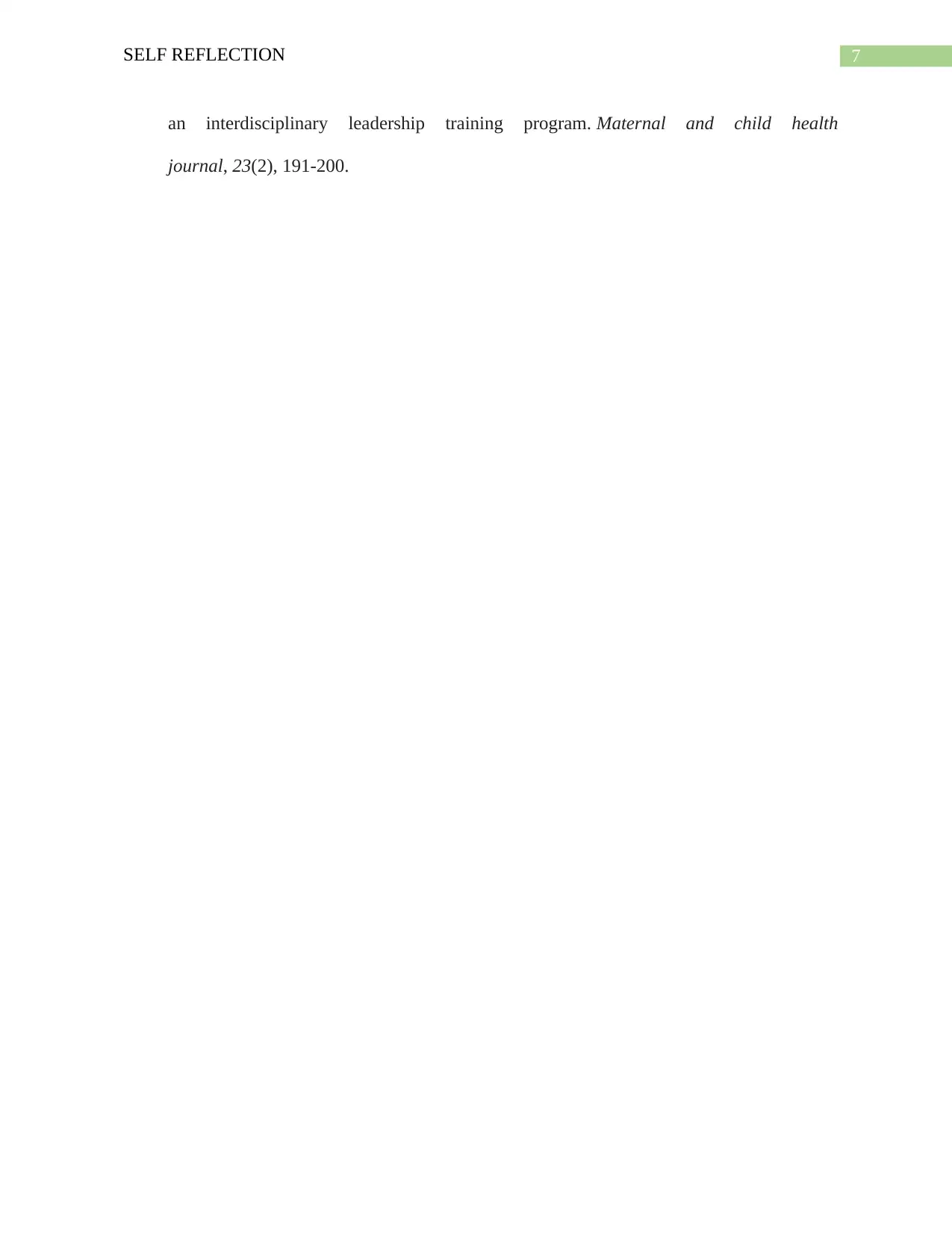
7SELF REFLECTION
an interdisciplinary leadership training program. Maternal and child health
journal, 23(2), 191-200.
an interdisciplinary leadership training program. Maternal and child health
journal, 23(2), 191-200.
1 out of 8
Related Documents
Your All-in-One AI-Powered Toolkit for Academic Success.
+13062052269
info@desklib.com
Available 24*7 on WhatsApp / Email
![[object Object]](/_next/static/media/star-bottom.7253800d.svg)
Unlock your academic potential
© 2024 | Zucol Services PVT LTD | All rights reserved.





